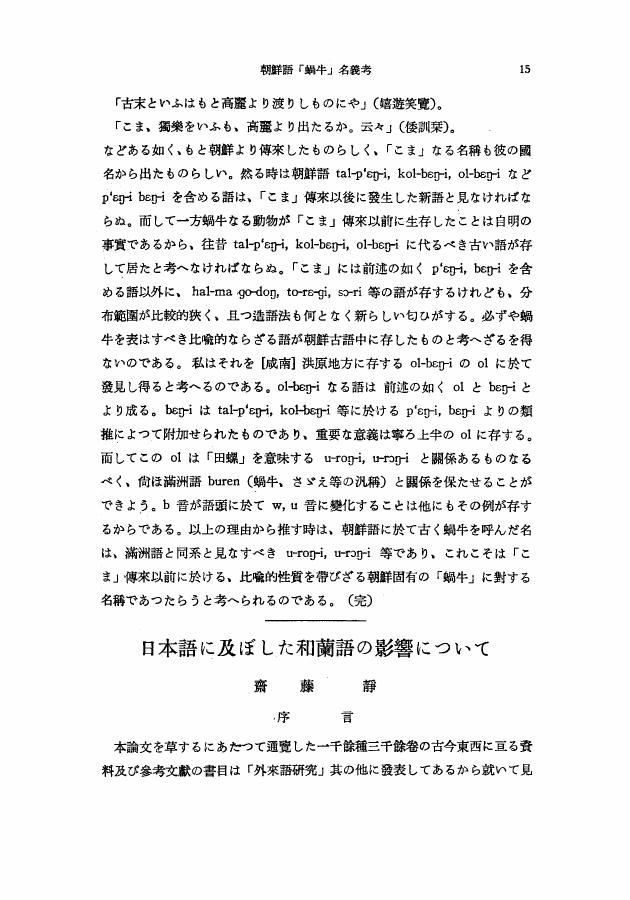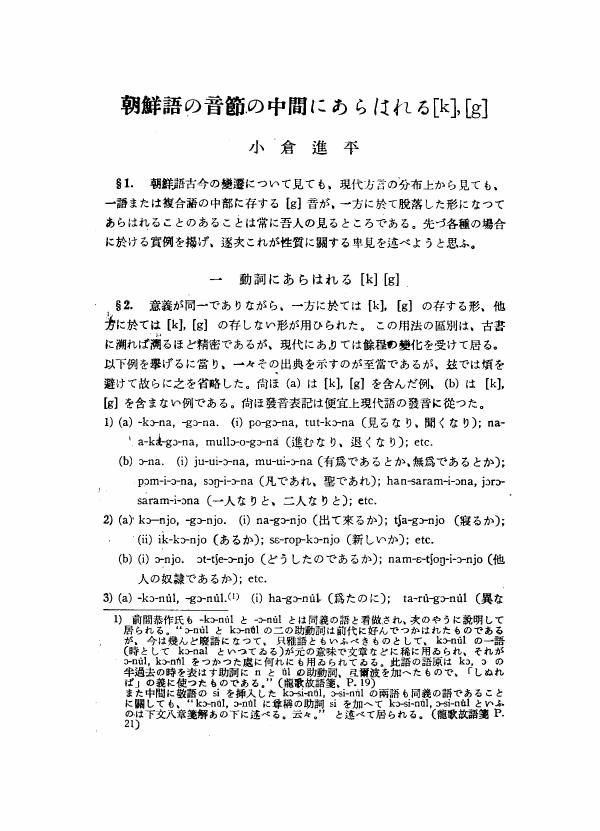1 0 0 0 OA ジンポー語における語頭NC連続の音韻構成
- 著者
- 倉部 慶太
- 出版者
- The Linguistic Society of Japan
- 雑誌
- 言語研究 (ISSN:00243914)
- 巻号頁・発行日
- vol.161, pp.119-137, 2022 (Released:2022-05-20)
- 参考文献数
- 51
鼻音と子音の連続(NC連続)は,分離可能性,音節化,分節音性などの観点から様々な構成を示しうる。東南アジアでは語頭のNC連続が語族を越えて広く観察されるが,従来の多くの研究ではその音韻構成が充分に検討されてこなかった。本稿では,ジンポー語(シナ・チベット語族:ミャンマー北部)に観察される語頭のNC連続を検討し,様々な音韻的・非音韻的現象をもとに,この言語のNC連続が異音節クラスターであることを示す。具体的には,話者の直感,聞こえ度,有声性,声調付与,形態構造,単音節標的型接辞,部分重複,並列複合語の語順,挿入型ルドリング,韻文の音節調整,歌詞とメロディーのアラインメントなど様々な現象において,語頭のNC連続が異音節クラスターとして振る舞うことを指摘する。明瞭な異音節クラスター型のNC連続を持つジンポー語から得られた議論は,異なるタイプのNC連続を持つほかの言語の分析にも示唆を与える。
1 0 0 0 OA 台湾の宜蘭クレオールにおける否定辞 ―「ナイ」と「ン」の変容をめぐって―
- 著者
- 簡 月真 真田 信治
- 出版者
- 日本言語学会
- 雑誌
- 言語研究 (ISSN:00243914)
- 巻号頁・発行日
- vol.140, pp.73-87, 2011 (Released:2022-03-08)
- 参考文献数
- 22
台湾東部,宜蘭県の山間部に日本語とアタヤル語とが接触して形成された新しい言語が存在する。われわれは,この言語を「宜蘭クレオール」とネーミングして記述調査をおこなっている。本稿では,まず,この宜蘭クレオールの概況を説明し,社会・歴史的背景および言語的特徴から,それがまさに「クレオール」であることを示す。次に,「宜蘭クレオール」の独自の体系を示す事象として否定辞を例に考察をおこなう。考察の結果,基層言語であるアタヤル語の「既然法」「未然法」といった範疇の中に上層言語(語彙供給言語)である日本語の否定辞「ナイ」と「ン」の2形式が巧みに取り込まれ,「発話以前(既然)の事態・行為」と「発話以後(未然)の事態・行為」を,それぞれnayとngによって弁別して描写するといった新しい体系化が図られていることが明らかになった。
1 0 0 0 OA 日本語に及ぼした和蘭語の影響について
- 著者
- 齋藤 静
- 出版者
- 日本言語学会
- 雑誌
- 言語研究 (ISSN:00243914)
- 巻号頁・発行日
- vol.1939, no.2, pp.15-33, 1939-04-20 (Released:2010-11-26)
- 参考文献数
- 15
1 0 0 0 OA 意味的分類の科学的妥当性
- 著者
- 守田 貴弘
- 出版者
- 日本言語学会
- 雑誌
- 言語研究 (ISSN:00243914)
- 巻号頁・発行日
- vol.144, pp.29-53, 2013 (Released:2022-03-08)
- 参考文献数
- 35
本論文は,言語学におけるさまざまな分類の根拠を問うこと,特に,意味に基づく分類がいかにして正当化されるのか検討することを目的としている。言語学は科学の一種だと考えられている。しかし,言語学におけるすべての分類が「何らかの操作を行い,その操作に対する同質かつ恒常的な反応によって分類を決定する」という科学的要請に応えているわけではない。特に,意味的分類は検証可能な分類基準を設定することが難しく,科学性を保持することが困難であるにも関わらず,現在の言語研究ではほとんど不可欠である。では,何がこの意味的分類を正当化してくれるのだろうか。本論文では,意味的分類を支えてくれる条件として,(1)分類の動機が研究者の間で共有されることと,(2)当該の分類によって現象がより良く説明され,他の現象に対しても一定の説明力を有することの2点を提案する。
1 0 0 0 OA 朝鮮語の音節の中間にあらはれる [k], [g]
- 著者
- 小倉 進平
- 出版者
- 日本言語学会
- 雑誌
- 言語研究 (ISSN:00243914)
- 巻号頁・発行日
- vol.1941, no.7-8, pp.1-16, 1941-04-30 (Released:2010-11-26)
- 参考文献数
- 3
- 著者
- 松本 克己
- 出版者
- The Linguistic Society of Japan
- 雑誌
- 言語研究 (ISSN:00243914)
- 巻号頁・発行日
- vol.1984, no.85, pp.148-157, 1984-03-31 (Released:2013-05-23)
- 参考文献数
- 19
1 0 0 0 OA 日本の子どもの初期の語彙発達
- 著者
- 小椋 たみ子
- 出版者
- 日本言語学会
- 雑誌
- 言語研究 (ISSN:00243914)
- 巻号頁・発行日
- vol.132, pp.29-53, 2007 (Released:2022-03-08)
- 参考文献数
- 36
日本の子どもの初期の語彙の構成を日本語マッカーサー乳幼児言語発達質問紙(JCDIs)標準化データ,縦断データ,横断データから明らかにした。特に子どもの初期の語彙が名詞優位か動詞優位かの問題を検討した。第1にJCDIsで語彙の構成を調べた結果,名詞が一番高い比率を占めていた。第2に,JCDIsで20ヶ月児158名の名詞,動詞,形容詞,閉じた語の語彙の構成を調べた結果,名詞の比率が高く,Bornstein et al.(2004)の7カ国の結果と一致していた。第3に2名の子どもの縦断データから語彙急増期の後は名詞優位,その後,文法発達に伴い動詞優位になることを明らかにした。母親の語彙は動詞優位であった。第4に,31名の日本の子どもと養育者の玩具場面と絵本場面の観察では絵本場面では一貫して名詞優位であったが,玩具場面では言語発達に伴い動詞優位に移行していった。玩具場面の養育者の発話は動詞優位で子どもの結果とは一致していなかった。以上の結果から,言語発達初期の子どもは名詞を学習しやすい概念的な傾向を有していると結論づけた。最後に名詞優位を引きこす語学習のメカニズムについて論じた*。
1 0 0 0 長崎通事のポルトガル語について
- 著者
- 土井 忠生
- 出版者
- 日本言語学会
- 雑誌
- 言語研究 (ISSN:00243914)
- 巻号頁・発行日
- vol.1969, no.54, pp.73-83, 1969
"Nanshizakkai"is a manuscript of three volumes, which was transcribed by a Tongking jurubaca (means an interpreter in Malay word), Gi Gozaemon (d. 1835). This book has a charactor which is called one of the Japanese-Portuguese dictionary, and in which we find the Portuguese language used by interpreters in Nagasaki during 17 th and 18 th centuries, and also we recognize some linguistic features of Portuguese spoken among the Japanese interpreters. Of course the phase of it was different from that of some lingusitic works compiled by Jesuit missionaries in 16 th and 17 th centuries. In this book Portuguese is written by Katakana. We are able to ascertain the practical pronunciations of that time by means of that orthography. First of all, double consonants in one syllable of Portuguese were reduced to open syllables according to the Japanese syllabic type, e. g. <I>letra</I>><I>reutara</I>, <I>escrito</I>><I>esukirito</I>; second, two words fused into one, e. g. <I>ja</I> <I>estou</I>><I>jastou</I>, <I>de</I> <I>ontem</I>><I>dontem</I>, and also abbreviations were often used, e. g. <I>alguma</I>><I>goma</I>, <I>ainda</I>><I>ain</I>.<BR>The word order was freely treated, e. g. Portuguese word order was arranged by Japanese order. The compiler of this book explained that the following three expressions had the same meaning: <I>arroz</I> <I>um</I> <I>fardo</I>, <I>um</I> <I>fardo</I> <I>arroz</I>.<I>fardo</I> <I>um</I> <I>arroz</I><BR>Portuguese has the complicated system of conjugations, of which interpreters, generally speaking, adopted present an preterite of Indicative. They used infinitive and present for other conjugated forms. Subjects did not always coordinate with Predicates in Person and Number. The form of Third Person, Singular of Conditional expressed more honorary than usual Imperative form. e. g.<BR><I>Anda por deante. Arnie Vossa Merce por deante</I>.<BR><I>Faze corn deligencia. Faza Vossa Merce corn deligencia</I>.<BR><I>Descobri</I>.<BR>Descobra Vossa Merce.<BR>This proper use in Portuguese syntax was exactly kept by the Japanese interpreters, because it has the correspondency to the sence of Japanese honorifics.<BR>It had the special function to compound with aru after Portuguese words or sentences. <I>Aru</I> was added at the end of predicate or sentence, to make sure of the meaning of preceeding words. e. g. <I>Ir templo aru</I>. <I>Veio arudo</I>. <I>Assi como imitar aprende aru</I>. <I>Saber de coy dearudo</I>. Näo <I>tern novas deyado</I>. Meu (<I>genitive was used for nominative</I>) <I>de dia de</I><I>noite tern sono aru</I>. It seems to me that it had some relations to the Portuguese verb ending, <I>ar</I>, at the same time, to the Japanese verb, <I>aru</I>.<BR>I will, therefore find out the facts of Japanese influence upon Portuguese, at any rate I would like to point out the Japanese sentence particle, ya was added to interogative sentences, and other sentence particles, <I>yo</I>, <I>do</I> were added to imperative forme. e. g. <I>Vossa</I> <I>Merce ter fome ya</I>? <I>Que parte veio ya</I>? <I>Vive yo</I>! <I>Escreva memoria do</I>!
1 0 0 0 チャム語中のクメール語的要素
- 著者
- 坂本 恭章
- 出版者
- 日本言語学会
- 雑誌
- 言語研究 (ISSN:00243914)
- 巻号頁・発行日
- vol.1969, no.55, pp.95-97, 1969
1 0 0 0 言語の理解度と語彙量との関係:カンボジア語のテキストを例として
- 著者
- 坂本 恭章
- 出版者
- 日本言語学会
- 雑誌
- 言語研究 (ISSN:00243914)
- 巻号頁・発行日
- vol.1966, no.49, pp.43-54, 1966
1 0 0 0 日本語アクセントの再建
- 著者
- 上野 善道
- 出版者
- 日本言語学会
- 雑誌
- 言語研究 (ISSN:00243914)
- 巻号頁・発行日
- vol.130, pp.1-42, 2006
<p>現代方言と古文献資料に基づき,本土諸方言のアクセント祖体系を考える.高起群には従来の「高高高高…」の式音調を改訂して「高高中中…」の下降式を建てる.低起群には去声始まりのアクセント型などを組み込む.全体として,下降式と低進式の2つの式,それに昇り核と下げ核の2つの核からなる,従来よりも対立数を増やした私案を述べる.</p>
1 0 0 0 OA 奄美語の現況から
- 著者
- 松本 泰丈 田畑 千秋
- 出版者
- 日本言語学会
- 雑誌
- 言語研究 (ISSN:00243914)
- 巻号頁・発行日
- vol.142, pp.143-154, 2012 (Released:2021-09-15)
- 参考文献数
- 8
2009年にユネスコによって「危機言語」として指定された奄美語の現況を,本土出身の研究者(松本)と島出身のnative speaker(田畑)という異なった立場を持つ二名が,それぞれの立場から粗描した。粗描の方法は「1960年代までの奄美語」,「1970~80年代の奄美語」,「1990~現代の奄美語」に分け,それぞれの時代における奄美語の状況を,両名の直接見聞をふまえて述べる。(結論的にいえば)両名は,1960年代まではシマユムタ(伝統的方言)が生きて使われていた時代,1970~80年代はトンフツゴ(奄美共通語)が急速に広まった時代,1990年~現代はシマユムタが急速に消滅している時代ととらえている。 また,論文末には,明治以降に奄美大島旧笠利村赤木名集落の人々によって再開拓されたトカラ列島諏訪之瀬島の言語事情についても現況を簡単に報告した。
1 0 0 0 金田一春彦先生を偲んで
- 著者
- 早田 輝洋
- 出版者
- 日本言語学会
- 雑誌
- 言語研究 (ISSN:00243914)
- 巻号頁・発行日
- no.126, pp.145-148, 2004-12
1 0 0 0 現代日本語の表出語
- 著者
- バックハウス A. E.
- 出版者
- 日本言語学会
- 雑誌
- 言語研究
- 巻号頁・発行日
- vol.1983, no.83, pp.61-78, 1983
この小論の目的は, 現代日本語の語彙のうち, 「ぶつ」「みみっちい」 などのように, 語源的には和語でありながら, 一般の和語とは異なった特徴をもっている単語 (接辞も含む) を表出語 (expressives) と名づけ, その特徴を音韻, 表記, 意味, 文体の観点から分析し, 表出語が現代日本語の語彙の一つの語群を構成していることを主張することにある。ここでいう表出語は次のような特徴をもっている。<BR>(イ) 濁音で始まることがあり, 促音, 撥音, 拗音が現われやすい。<BR>(ロ) かな (原則として, ひらがな) で表記される。<BR>(ハ) 表出的, 感情的な意味をもつ。<BR>(ニ) 文体は話しことば的, 俗語的である。<BR>上記の特徴に注目しながら, 表出語をさらに中心的なものと, 周辺的なものとに区分けし, 代表的なものを出来るだけ多く例示してみた。
1 0 0 0 OA On the Reconstruction of Japanese Accents
- 著者
- Zendo Uwano
- 出版者
- The Linguistic Society of Japan
- 雑誌
- 言語研究 (ISSN:00243914)
- 巻号頁・発行日
- vol.Supplement.1, pp.117-154, 2021 (Released:2021-11-09)
- 参考文献数
- 31
Based on modern dialects and ancient documents, I propose a proto-accent system for the mainland Japanese dialects. For the high-beginning series I hypothesize a falling pattern of the form HHMM…, instead of the high-level pattern HHHH…. For the low-beginning series I incorporate the qu (departing) tone, that is, words with rising pitch, into the system. As a whole, the proto-system consists of two tonal registers, falling and low-level, and two accent kernels, ascending and lowering, producing a system that contains more oppositions than that previously proposed.
- 著者
- 簡 月真 真田 信治
- 出版者
- 日本言語学会
- 雑誌
- 言語研究 (ISSN:00243914)
- 巻号頁・発行日
- no.140, pp.73-87, 2011-09
1 0 0 0 ウィリアム・ジョーンズと印欧語族の認識
- 著者
- 田中 利光
- 出版者
- 学術雑誌目次速報データベース由来
- 雑誌
- 言語研究 (ISSN:00243914)
- 巻号頁・発行日
- vol.1988, no.93, pp.61-80, 1988
It has been remarked now and then that Monboddo and others had recognized the relationship of the Indo-European languages earlier than Jones (e. g. v. E. L. Cloyd, <I>American Anthropologist</I>, 71 (1969), 1134). In such a remark, however, usually it has been overlooked that their idea on the relationship of the European languages or of the European languages and Sanskrit was confused.<BR>Jones' idea or hypothesis that Sanskrit, Greek, Latin and others were derived “from some common source, which, perhaps, no longer exists” was excellent and probably original. Although partially his idea has been keenly criticized for the expression “perhaps”(e. g. v. H. Pedersen. The <I>Discovery of Language</I>, 1931, p.18), as for the point, Arlotto's interpretation (Introduction to Historical Linguistics, 1972, p.40) is considered correct.<BR>Now, can we say that Iones' hypothesis “was not, like Halhed' s theory, the result of a process of linguistic reconstruction”(v. R. Rocher, <I>Recherches de Linguistique</I>, 1980, p.178) No.We merely do not know how the detailed process was. And the all-over framework of the process appears simple and common but is to the point and masterly. It was succeeded to and developed later by F. Schlegel and others.<BR>Jones seems to maintain an ambiguous attitude toward Slavic. He seems to want to except it from the Indo-European family. And later Celtic appears to have been excepted, and Egyptian to have been included. If it is true, just these ideas were “not the result of a process of linguistic reconstruction.”
1 0 0 0 アフリカ人のコミュニケーション:―音・人・ビジュアル―
- 著者
- 梶 茂樹
- 出版者
- 日本言語学会
- 雑誌
- 言語研究 (ISSN:00243914)
- 巻号頁・発行日
- vol.142, pp.1-28, 2012
<p>サハラ以南のアフリカは,いわゆる無文字によって特徴づけられてきた。しかし無文字社会というのは,文字のある社会から文字を除いただけの社会なのだろうか。実際に現地で調査をしてみると,そうではなく,われわれの想像もつかないようなものがコミュニケーションの手段として機能していることがわかる。本稿では,私が現地で調査したもののうち,モンゴ族の諺による挨拶法と太鼓による長距離伝達法,テンボ族の人名によるメッセージ伝達法と結縄,そしてレガ族の紐に吊るした物による諺表現法を紹介し,無文字社会が如何に豊かな形式的伝達法を持ちコミュニケーションを行っているかを明らかにする。無文字社会では,言語表現が十分定形化せず,いわば散文的になるのではないかという一般的想像とは逆に,むしろ彼らのコミュニケーションは形式的であり韻文的である。それは文字がないことへの対応様式であり,共時的に,そして世代を通して伝達をより確かなものにする努力の表れと理解できるのである。</p>
1 0 0 0 OA 動詞「みる」の多義構造
- 著者
- 田中 聡子
- 出版者
- The Linguistic Society of Japan
- 雑誌
- 言語研究 (ISSN:00243914)
- 巻号頁・発行日
- vol.1996, no.110, pp.120-142, 1996-12-20 (Released:2007-10-23)
- 参考文献数
- 14
This paper presents an analysis of the polysemic structure of the verb‘mire (see)’. The word is used with various meanings. But all of its meanings, including those which seem to be arbitrarily extended, can be proved to be motivated and characterized by the nature of human cognition.Its meanings are not discrete but in their typical uses they are discernable by semantic features. The fundamental meaning (m.1) of ‘mire’may be expressed in terms of the semantic features: <visual‹ <perception› . This assumption is supported by the fact that it is usually received in this meaning when it lacks the object word i.e. in the default case.The other meanings can be accounted for based on three principles of derivation which can be said to be psychologically valid: (1) incorporation of interpretive inferences into lexical meaning, (2) metaphor, and (3) metonymy.principle (1) ...... m.2: <visual‹ <perception› <judgement‹ ; m.3: <judgement› ; m.4: <visual‹ <perception› <judgement‹ <taking measures›principle (2) ...... m.5: <non-visual‹ <perception› <judgement‹principle (3) ...... m.6: varying from <experience of a state of affairs› to <occurrence of a state of affairsThe variations of m.6 reflect the degrees of “subjectification”(Langacker 1990: 316) of the viewer construed by the conceptualizer.


